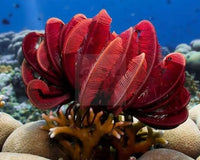These Beautiful plant-like creatures have mastered the art of camouflage.
They hide in plain sight among bright corals and anemones on reefs, firmly anchored to the sea floor, as their slender, branching limbs billow like colorful fern fronds.
These are crinoids, members of the echinoderm family that also includes sea stars and sea urchins.
There are 600 or so species of crinoid on Earth, and they’re found all over the globe, in both shallow waters and at depths of up to 9,000 meters below sea level.
While many crinoids develop stalks to attach themselves to the sea floor as juveniles, they often lose these as adults.
Things get positively weird when they break free swimming, floating, or even walking through the ocean.
The species that keep their stalks through to adulthood are called sea lilies, because they look like underwater flowers whilst those that lose their stalks become known as feather stars.
Feather stars can still anchor themselves to rocks and substrate if they need to, using a set of tiny legs called cirri.
Feeding
How feather stars actually get food into their mouths is a whole other story.
The process begins with the foot furthest away from the mouth being cleaned by the foot directly below it, bundling up the mucus-filled snack before transporting it, foot by foot, along the arm.
The next foot down wraps around the one above it, and scrapes the food off for a second time. This process continues all the way down the arm of the feather star, creating a bolus of food that gradually increases in size.
The bolus eventually makes it to the mouth, where it is ingested in a U-shaped gut.
Composing
Those lovely fringed arms are covered in tiny, mucous-secreting tube feet that can move independently of each other, and this allows the feather stars to catch plankton and other microscopic morsels floating through the water.
The stem, the calyx, and the arms are three main sections of a crinoid. Connected by thin ligamentary tissue, these parts of the body often regenerate to maintain an inner layer of protection.
Feather stars are known for being self-sufficient. Their bodies have evolved over time to decompose and recuperate when necessary.
Moving around
While feather stars have the ability to move around, they are very rarely caught doing it, and until recently, it was assumed that they were extremely slow moving. researchers have recorded feather stars moving at up to 5 centimeters per second. Although this might not seem like an incredible
speed, it is essential for their health and survivability.
Their speed primarily depends on gender, native tendencies, and vicinity of predators. Here is what they look like when they are swimming, and it is honestly so mesmerizing.
Life Cycle
These marine animals reproduce every 10-16 months. Reproduction consists of a larval stage, free swimming period, and pinnacle stage. Male and female creatures often live in different habitats, which makes breeding periods unique to the colony.
Natural events are particularly dangerous to the species, as their life cycles depend on strict timeframes. If a mating season is disrupted, the nearby population could be in jeopardy.
FEATHER STARFISH: NATURE'S MASTER OF CAMOUFLAGE AND CREATIVITY





